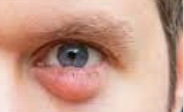Scientific studies show that as many as 78% of all adults have some form of ocular surface disease (OSD).
What is OSD?
Ocular surface disease (OSD) and dry eye syndrome are often mistakenly considered synonymous.
OSD occurs when there is damage to the front surface of the eyes, the cornea.
However, OSD is a much broader term, which includes dry eye syndrome, but also refers to a number of other disorders that affect the surface of the eye, and can cause significant issues with your vision and quality of life.
Is OSD serious?
Yes.
OSD is a major eye health issue that can lead to permanent loss of vision, even blindness.
OSD occurs when the eye damage occurs and if not treated early can lead to life-long consequences for both vision and eye comfort.
Healthy tear production is the key to keeping your eyes well hydrated, as well as preventing damage to your eyes and keeping them free of dirt and other foreign bodies.
What Causes OSD?
The most common causes of OSD are malfunctioning of the eye’s water and oil glands and inflammation of the eyelids, known as blepharitis.
If any ocular gland is not functioning correctly, it affects tear quality or quantity, leading to dry eye syndrome or other forms of ocular surface diseases.
Specific glands are responsible for your tear quality. The lacrimal gland produces water, and the meibomian glands located inside the eyelids, produce the essential oily layer of the tears. Both glands play an essential role in the production and maintenance of healthy tears.
While dry eye syndrome is among the most common types of OSD, there are several others:
- Eye allergies
- Blepharitis
- Decreased tear quality and/or production with age
- Chemical or thermal burns
- Side effects of medical treatments or prescription medications
- Keratitis
- Sjorgen’s disease and other immunological conditions
- Meibomian gland dysfunction
- Conjunctivitis
Do I have OSD?
If regular eye drops have not improved your dry eyes, then you most likely have OSD.
Signs and symptoms of ocular surface disease may vary slightly, depending on the underlying issues.
The majority of ocular surface diseases will have many of the same symptoms, often worsening at night or in windy or dry conditions.
The signs and symptoms of OSD include:
- Dry, gritty feeling in the eyes
- Constant feeling like something is in your eye
- Light sensitivity
- Itchy eyes
- Blurry vision
In many cases of OSD, as in dry eye syndrome, these symptoms are chronic, and the usual eye drops purchased at a pharmacy will not have had a long lasting benefit.
However in cases where symptoms are the result of injury or irritants in the environment, they will dissipate as soon as the injury is healed or the irritant is removed.
SEE RELATED: Holistic Dry Eye Treatments: 8 FAQs
If you suffer with any signs above you may have OSD, schedule an appointment with an eye doctor near you to discuss the effective treatments.
How is OSD diagnosed?
In order to determine the best treatment your eye doctor will first ask you a few questions.
These questions may include:
- When did you first start experiencing dry eye symptoms?
- How often do you experience symptoms, and are there specific situations or places when/where they worsen?
- Have you been receiving treatment, or been prescribed medication, for any other medical conditions?
- Have you already tried any treatments for OSD, and did you feel they worked well for you?
- Is there a family history of OSD or other conditions that affect the eyes?
Once you’ve answered these and any other questions your eye doctor has, they will have a better idea of what might be causing your symptoms. They will then perform in-office testing.
Depending upon the type of OSD your eye doctor suspects, specific dry eye tests might include:
Tear break up time (TBUT)
By observing the tears in this way, your eye doctor can evaluate the rate of evaporation of your tears.
Corneal examination
This exam will help the eye doctor diagnose any corneal damage that may have resulted from OSD.
Corneal damage can lead to life-long vision problems including ocular discomfort and loss of vision or even blindness.
Meibomian gland evaluation
Your eye doctor will evaluate your meibomian glands, which are tiny glands lining the edges of your eyelids. These glands produce oil to prevent tears from evaporating too quickly.
Phenol red thread test
This test allows your eye doctor to check if the water layer of your tears has broken down by measuring the volume of your tears.
If the water layer has broken down, tears may not spreading over the eye, giving you a constant feeling of dryness in your eyes.
Schirmer’s test
This is probably the most common test for dry eye syndrome and other types of OSD.
Your eye doctor will place a small strip of medical paper inside your lower eyelid and ask you to close your eyes. This test allows an eye doctor to evaluate how far your tears travelled on the paper while your eyes were closed.
Once your eye doctor has conducted these tests, they will be able to determine whether you have OSD, and discuss treatment options.
How is OSD treated?
To avoid permanent corneal damage, OSD requires in depth treatment from an eye doctor.
Depending on the specific type of ocular surface disease in question, effective treatment will vary.
In most cases treatment will include any combination of:
- Prescribed eye drops
- Warm compresses and eye massages
- Eyelid scrubs
- Cyclosporine and other anti-inflammatories
- Non-steroid anti-inflammatory medications
- In-office treatments
In rare cases, eye doctors will sometimes prescribe antibiotics to be taken orally, or steroid treatments to be applied topically.
In-office devices are an effective treatment for the cause of OSD and to decrease symptoms.
Specifically with blepharitis, specific in-office devices are commonly used.
These non-invasive procedures effectively warm up the glands to allow the oil to flow, they can even decrease the inflammation around the eye or eliminate the bacterial cause of the OSD.
LEARN MORE: Guide to Dry Eye
Don’t let OSD impact your lifestyle, schedule an appointment for a comprehensive dry eye exam, to find a solution that works best for you.
OSD is a major eye health issue that can lead to permanent loss of vision, even blindness.
OSD occurs when the eye damage occurs and if not treated early can lead to life-long consequences for both vision and eye comfort.










